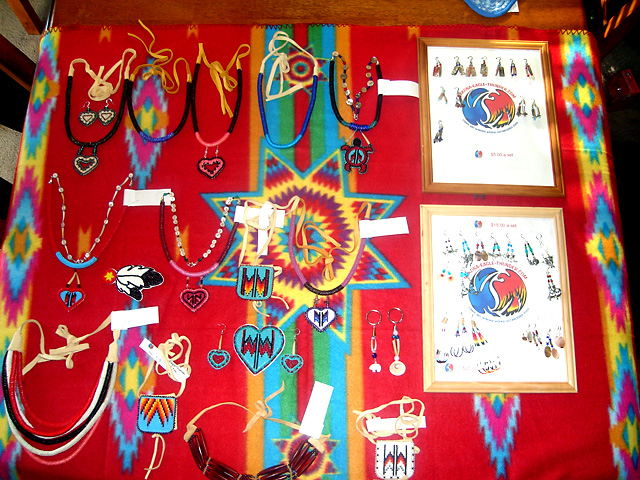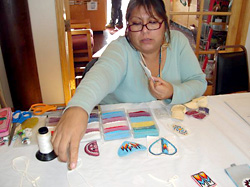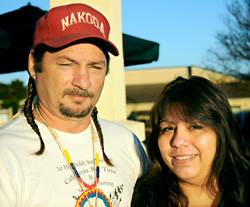
The McKinleyville, Calif., couple has more than 60 years of combined beading experience and will offer the local community a chance to tap into their vast wealth of knowledge via a course offered this spring through Humboldt State’s Extended Education program. The course, Native American Beadwork, Design & Leatherwork, teaches students skills in Native American Indian beadwork and design using traditional and modern materials. This is the second semester the class will be offered.

“I believe all of our students from the last class will be in this semester’s class again,” Winema says. “We got nothing but positive feedback, the only thing the students said is that they wanted more time with us. So, we thought it would make sense to have class this time on both Mondays and Wednesdays and we’re accessible by email and phone for students’ questions.”
Lonnie and Winema both began beading at a young age. Lonnie is an enrolled member of the Three Affiliated Tribes of North Dakota and his bloodline is Assiniboine-Sioux and Arikara. He is a pipe carrier and Sundancer for the Assiniboine people of the Fort Peck Tribe in northeastern Montana. He was separated from his family and community in Wolf Point, Mont., when he was 10 years old and sent to an Indian boarding school in Oklahoma. It was there Lonnie learned to bead and by age 11 he was winning art competitions, beating out high school students.
“We believe it’s your gift. Like some people are good with writing or photography, it’s just a natural talent,” he says.

Winema is Paiute enrolled with the Klamath Tribes of Chiloquin, Ore., and became a Cap Wearer, or Keeper of the Culture, at only 24 years old. She learned to bead at the age of eight and has been teaching beading since the 1970s. She helped teach beading and facilitated sweats and other ceremonies in California prisons with Lakota medicine man Archie Fire Lame Deer, taught beading in both Sacramento and Eureka, Calif., school districts, and sells her work locally at numerous locations including Abraxas Jewelers in Eureka. She and Lonnie’s work has also appeared in museums and is for sale on their website. The couple even designed a beaded bow tie and pair of moccasins for John Bohlinger, lieutenant governor of Montana.
“Some people knit, I bead,” Winema says. “Most times I bead from 10 at night to maybe three in the morning—no phone, nobody’s going to knock on the door. When my first marriage failed, beading was what I had to fall back on. I didn’t really make a business out of it until I said, ‘I’ve been a housewife for 30 years, my kids are all grown—what are my skills?’ Well, I could bead and people were always asking for it. So, I was able to pay my rent, buy a car, pay my insurance, just by myself running a business.”
While Indian people in North America had used beads or bead-like objects including shell, pearl and stone for thousands of years to adorn clothing or sacred items, Europeans introduced Italian and Czech glass beads in the 16th and 17th centuries, thus altering the course of Indian beadwork. Winema and Lonnie emphasize that students in their class should originate their own designs rather than copying others, and to be aware that expert level beaders are not created overnight or even over a year’s time. The couple also stresses that they have no wish to impose their culture, religion or beliefs on the class.
“Our first HSU class was a learning experience for us and the students,” Winema says. “We realized there were different skill sets. You might think adults would be quicker to learn, but they’re not. I guess when they say little kids pick up language faster it’s not just language. So, we had some older people in the class, but once they got their fingers moving and got into the groove, they started to figure it out.”
One final benefit Lonnie notes is the communal and social nature of beading.
“In college they have study groups and we definitely encourage our students to start—well, what I would call societies—where you have a Friday or Saturday afternoon and you have some coffee and sit and work together and gossip and just have a good time.”
NOTE: The Native American Beadwork, Design & Leatherwork course runs from Feb. 18 to May 6 and meets on Mondays and Wednesdays from 6 to 8 p.m. Both an introduction and advanced course are offered. Lonnie and Winema would like to stress that all people are welcome regardless of age or experience and that the couple will “do our best to teach a craft that is enjoyable and a very adaptable art form.” For more information on registering call HSU’s Extended Education at (707) 826-3731 or visit HSU’s Extended Education program.